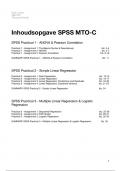Case uitwerking
SPSS PRACTICALS uitwerkingen Technieken voor causale analyse (MTO-C) 2024
Hallo allemaal! Deze bundel heeft alles wat je nodig hebt voor SPSS bij MTO-C (Technieken voor Causale Analyse) op Tilburg University. Alle oefenopdrachten zijn hierin uitgewerkt, plus de antwoorden van de SPSS-tentamens van 2022 en 2023. Met deze bundel hoop ik dat je dit onderdeel met een PASS...
[Meer zien]




